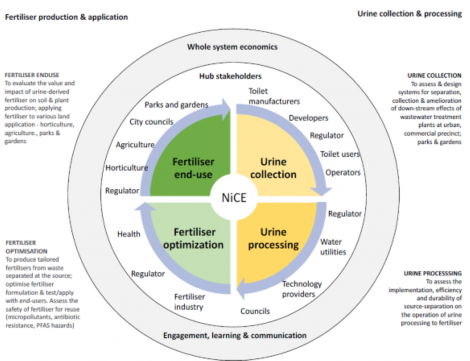ARC NiCE Research Hub
Under the $2 million ARC Research Hub for Nutrients in a Circular Economy (NiCE), researchers from Cities Research Institute (CRI) are investigating the economic feasibility and practicality of converting human urine to fertiliser as well as any potential health risks and the public response.
About
For the first time in Australia, the NiCE Hub will take a holistic approach to tackling the challenge of urban, decentralised processing of urine to fertilisers, tailored for Australian conditions. It will engage all end-users across the system to jointly establish acceptable technology, practices and products; planning, installation and operational guidelines; understanding of the impacts on current infrastructure; and a viable business model based on a whole-of system economic assessment.
Within the four-year timeframe of the project, the Hub’s goal is to deliver a roadmap to precinct-scale implementation of urine diversion, enabling and launching a viable circular nutrient economy that is scalable to a large-size city (>100,000). Its vision is for Australia to have a resilient wastewater industry, resilient agriculture and horticultural sectors, a healthy environment, and a strong manufacturing industry for advanced membrane, biotech and sensor technologies—all underpinned by a circular economy of nutrients
The team
Led by Chief Investigator Associate Professor Cara Beal, the NiCE team at Griffith will play a key role in the four year project through three major research foci:
Health-based Risk Assessment: Assessing the microbiological and chemical health risks –led by NiCE Chief Investigator Prof Anne Roiko ( CRI , School PAM ).
Whole-of-system Economics: the economic feasibility of urine-sourced fertiliser including logistics—storage and movement of urine/fertiliser; integration with existing plumbing and know-how; effectiveness of new fertiliser compared to market standard. (led by NiCE CI A/ Prof Sayed Iftekhar, ARI , Griffith Business School).
Social and Regulatory Acceptance: How to positively engage both public and regulatory authorities around the safety and efficacy of the nutrient extraction technology and fertiliser application (led by A/Prof Cara Beal, CRI , Griffith Business School PAM ).
Other Hub research partners include:
- University of Technology Sydney (lead organisation with Chief Investigator Professor Hokyong Shon),
- University of Melbourne – Chief Investigator Stefano Freguia,
- Western Sydney University - Chief Investigator Professor Jeff Powell and
- University of Southern Queensland - Chief Investigator Professor Bernadette McCabe.
Mining liquid gold in city parklands
Proposed Outcomes
The Hub proposes to help relieve these pressures on the wastewater treatment industry by making it viable to separate urine at source, then recover nutrients and recycle them as liquid fertilisers with economic value. We focus on urine because it is a small stream to collect and yet is rich in nutrients. In urban sewage, urine typically contributes less than 1% of the flow but typically comprises 80% of the nitrogen (N), 50% of the phosphorus (P) and 70% of the potassium (K)1. Source separation and nutrient recovery have a long history associated with rural areas.
The challenge is processing urine waste in a decentralised manner, at scale, in urban areas. It is a multi-faceted challenge encompassing technical barriers (recovery of nutrients with minimal energy or chemical input; processing of those nutrients into transportable fertilisers free of pathogens and micropollutants); economic barriers (logistics—storage and movement of urine/fertiliser; integration with existing plumbing and know-how; effectiveness of new fertiliser compared to market standard); social barriers to using urine separating toilets and urine-derived fertilisers (concerns with odour, safety, cleaning); and political barriers (regulatory regimes for protecting environmental and public health).
Opportunities and prospectus
Australian cities are facing twin issues: ageing wastewater infrastructure and urban intensification. These require major investments in infrastructure replacement and upgrades —including sewer networks and wastewater treatment plants —as well as newly capable residential and commercial buildings. This wave of infrastructure renewal provides an opportunity to address the need to manage nitrogen and other pollutants, while delivering more flexible and adaptable solutions to transport and treat wastewater in fast -changing cities.
Media
- Griffith News - Mining liquid in city parklands
- ABC News - Researchers pitch pee-based fertiliser trial to make Brisbane parks a wee bit better
- The Guardian - Liquid Gold : Australian scientists look to recycle human urine to fertilise city parks
- The Daily Mail - You must be taking the p***! Australia is trialling using HUMAN URINE as fertiliser for plants and lawns in city parks
